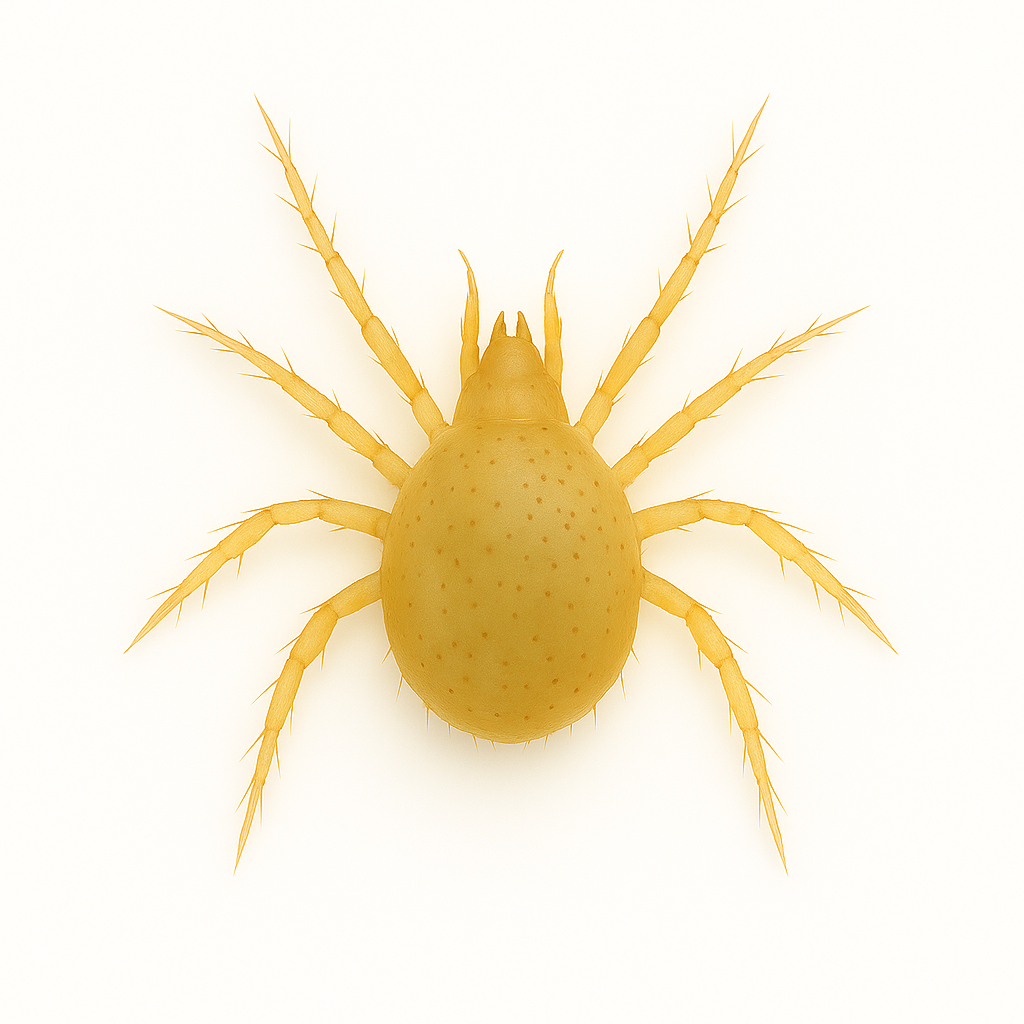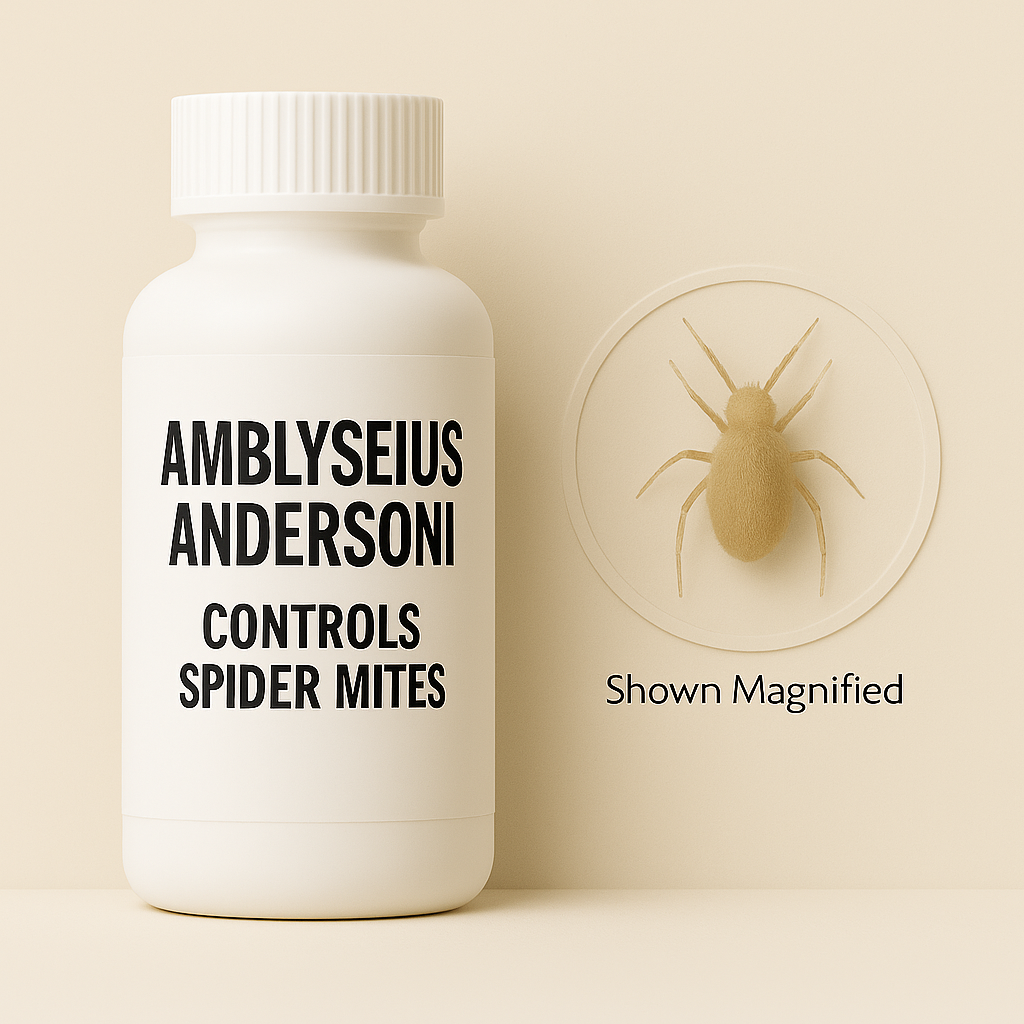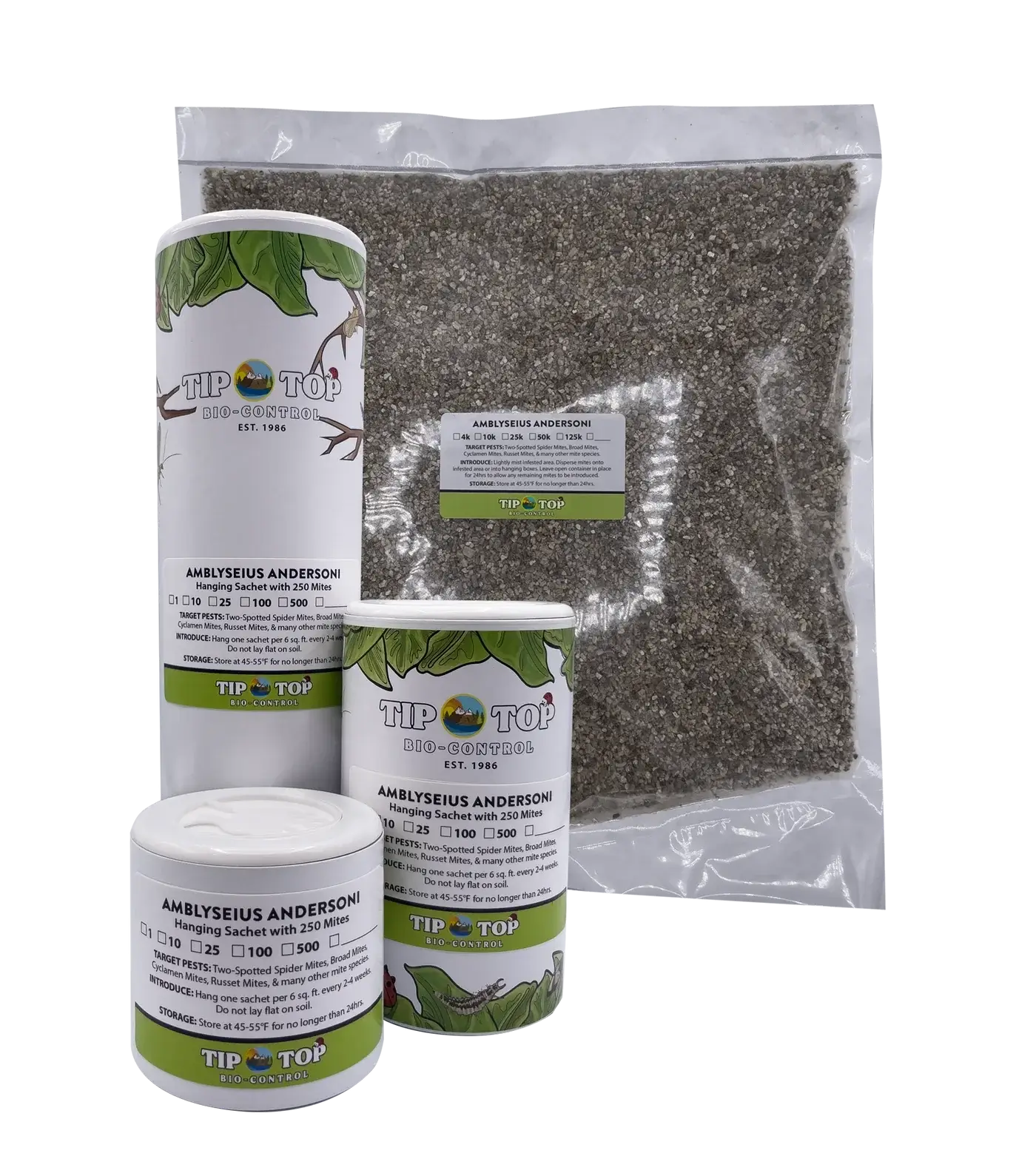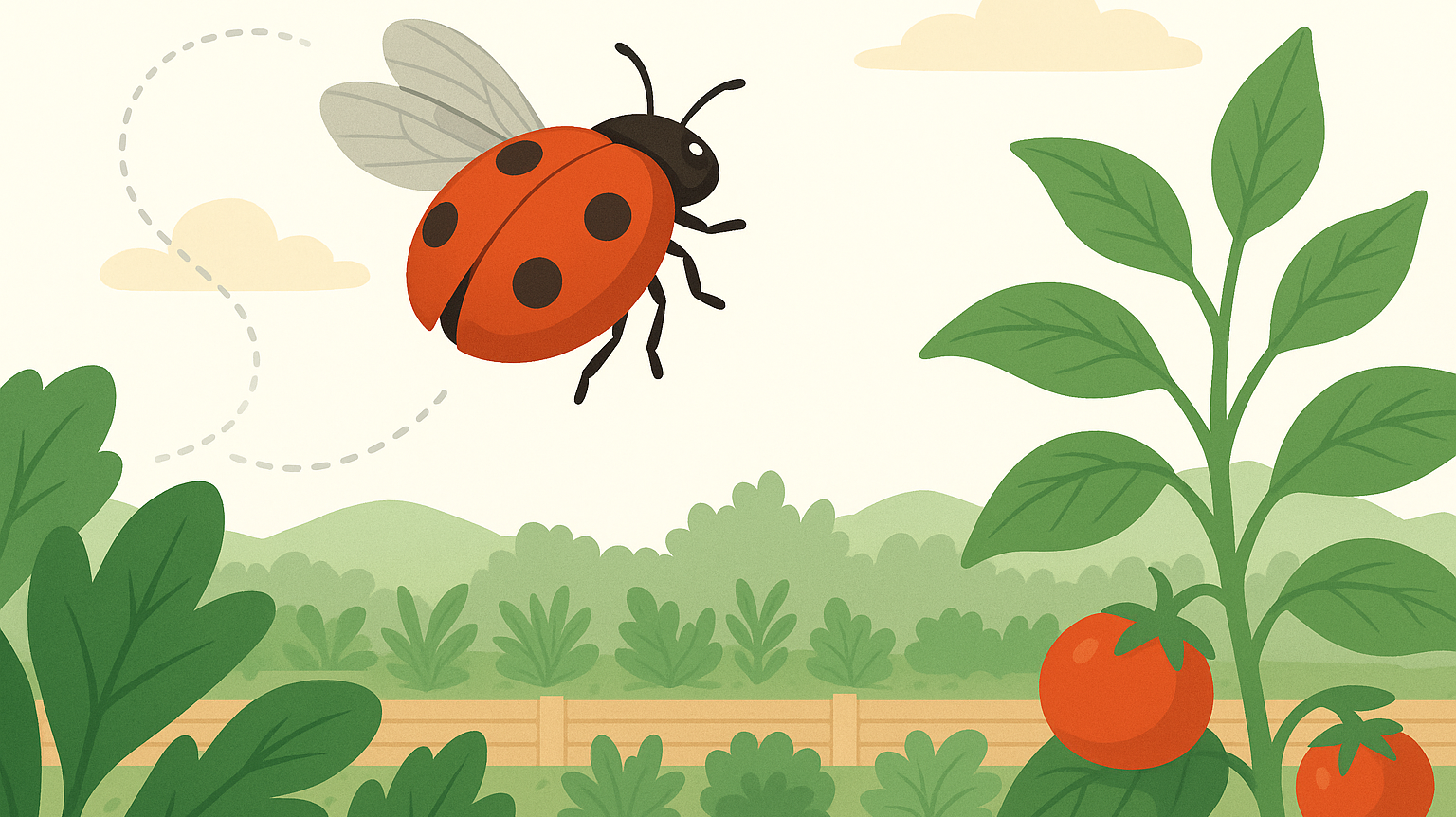When the Climate’s Unstable and the Pests Are Multiplying…
You don’t need perfect conditions. You need Andersoni.
Amblyseius andersoni Bottles
Fast-Acting Predatory Mites for Mixed Mite Infestations in Unpredictable Environments
When nothing else can keep up, Amblyseius andersoni can.
These tough, fast-moving predatory mites thrive in fluctuating climates and knock down a wide range of soft-bodied mite pests. They arrive as adults only—no eggs, no wait time—ready to hunt on contact.
Andersoni is ideal for growers dealing with:
-
Temperature swings
-
Humidity changes
-
Multiple mite species active at once
What It Controls
| Pest | Notes |
|---|---|
| Spider mites (T. urticae, T. pacificus, etc.) | All stages |
| Broad mites | Excellent suppression |
| Russet mites | Effective with full coverage |
| Cyclamen mites | Targets early-stage populations |
| Eriophyid mites | One of few predators that helps |
| Gall mites | Useful in orchards and ornamentals |
Why Bottled Adults?
| Feature | Benefit |
|---|---|
| Immediate suppression | No hatch delay—adults feed on release |
| Wide temperature range | Active from 42–100°F |
| Multi-species control | Works across at least six pest types |
| No guesswork | No colony-building required—just open, sprinkle, and go |
When you're managing infestations, not hypotheticals, bottled Andersoni is your first move.
Best For
| Grow Type | Use Case |
|---|---|
| Greenhouses | Hot during the day, cool at night |
| Indoor tents | Variable RH and multiple pests |
| Outdoor crops | Broad + spider mite mix during transitional seasons |
| Ornamentals and aroids | Especially sensitive to pest damage |
| Farms and orchards | When eriophyid or gall mites sneak in |
How to Use It
-
Rotate bottle gently before opening
-
Sprinkle directly onto foliage, focusing on:
-
Undersides of leaves
-
Dense canopies
-
Active mite hot spots
-
-
Avoid watering or spraying for several hours post-release
-
Maintain moderate humidity and gentle airflow for best movement and egg laying
Dosage Recommendations
| Infestation Level | Mite Count |
|---|---|
| Light | 10 mites per sq. ft. |
| Moderate–Heavy | 15–25 mites per sq. ft. |
| High Value / Mixed infestations | Blanket coverage across affected area |
For long-term suppression, follow with Andersoni sachets to maintain population over time.
Pro Tips
-
Start with bottles for immediate knockdown
-
Layer in sachets for slow-release backup
-
Avoid pesticide residue on leaves pre- or post-release
-
Combine with Swirskii, Persimilis, or Californicus depending on pest overlap
-
Works even when your environment doesn’t—Andersoni is chaos-tolerant
Safe for People, Pets, and Plants
-
Will not bite, sting, or damage foliage
-
No residue
-
No re-entry restrictions
-
Compatible with organic and IPM growing
-
Suitable for edible crops and sensitive ornamentals
Shipping & Storage
-
Ships overnight with live delivery guarantee
-
Use on arrival for best results
-
Store at 45–55°F for up to 48 hours if needed
-
Do not freeze or expose to extreme heat
FAQ
How does the Live Guarantee work?
We know how important it is for your mites to arrive healthy and ready to work. That’s why we offer a live arrival guarantee—with flexible options depending on when we hear from you:
- Let us know within 24 hours of delivery: We’ll gladly send a free replacement shipment.
- Let us know within 2–3 days of delivery: We can offer store credit to make things right.
- After 3 days from delivery: Because these are living organisms, we’re not able to offer replacements or credit beyond that window. By then, it’s harder to know what went wrong or whether shipping conditions were a factor.
We truly want your mites to succeed—so please open your package as soon as it arrives and check on them. If something doesn’t look right, don’t wait—reach out and we’ll take care of you.
Where are you located?
We have a number of different locations in NJ, Maine and Oregon. While we'd love to have you, we are not currently open to the public.
Can I call you?
We get it. Sometimes it's easier to talk to someone, and on a case by case basis we can try to figure it out. Unfortunately though, we're really not able to take calls—FGMN is a small nursery, and we're usually elbows-deep in plants or packing boxes. To make sure nothing gets missed (and everyone gets a timely reply), we keep all communication in writing.
Feel free to message us at info@fgmnnursery.com. We mostly respond quickly, but every once in awhile replies may take a day. Do follow-up if you don't hear in that time. We're human, we miss an email here or there.
Too Many Options?
We get it. Try our mite/insect matchmaking quiz and instantly get matched to the solutions you may need.
Our Live Delivery Guarantee
We stand behind every leaf and every mite. If your plant or predatory insects don’t arrive alive on the first delivery attempt, we’ll make it right.
Here’s what you need to know:
- Email us at info@fgmnnursery.com within 24 hours of delivery
- Include clear photos of the item and the shipping label
- Someone must be available to receive the package—plants and bugs don’t do well sitting in the sun, a mailbox, or the back of a delivery truck
For plants, we offer store credit if something goes wrong.
For predatory mites and beneficial insects, you’ll have the choice of a replacement shipment or store credit.
If you contact us after the 24-hour window, we may still be able to help—just know it’s handled case by case.
We pack with care, insulate when needed, and check the weather before shipping. But once it’s in transit, the fastest way to protect your order is to open it right away.
Mite Matters
The Hidden Weather That Shapes Plant and Predator Life
Invisible weather shapes every growing space. Warm air pools under lights, cool air settles near the floor, and in between, tiny predators decide where they’ll thrive. Learn how microclimates influence the balance between plants, pests, and the mites that keep them in check.
If Ladybugs Are Just Going to Fly Away, Why Use Them?
Most ladybugs don’t fly off out of spite — they leave when the environment isn’t right. Learn how temperature, humidity, and shelter affect whether they settle or scatter, and how to create the ideal setup that keeps them working where you need them most.
Where Did My Predatory Mites Go?
Released predatory mites but can’t see them anymore? Don’t panic. Their invisibility is exactly what makes them effective. Learn why they vanish, how they hunt pests out of sight, and why reapplying keeps your plants protected.













